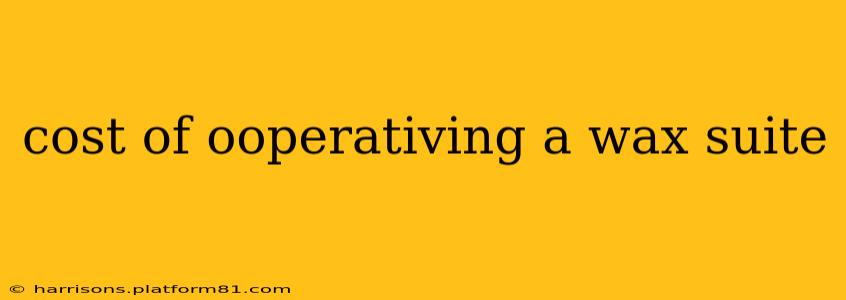Opening a wax suite requires careful planning and a realistic understanding of the associated costs. This guide breaks down the expenses involved, helping you create a comprehensive business plan and budget. We'll cover everything from initial setup to ongoing operational expenses, ensuring you're well-prepared for the challenges and rewards of owning your own wax business.
What are the startup costs of a wax suite?
Startup costs are the initial investments needed to launch your business. These can be substantial, so careful budgeting is crucial. Key areas to consider include:
- Leasehold Improvements: This covers any renovations or modifications to the space to meet your needs, such as installing flooring, lighting, and plumbing specifically suited for a waxing salon. Costs vary drastically depending on the size and condition of the space. Expect to budget thousands of dollars.
- Equipment: You'll need a range of equipment, including waxing pots, warming cabinets, spatulas, applicators, and a comfortable client chair. High-quality equipment is essential for providing a professional service, but it represents a significant upfront investment. Research different brands and models to find the best balance of quality and price.
- Supplies: Stocking up on wax (different types for various skin types and body parts), pre- and post-waxing products (cleansers, lotions, oils), and disposable materials (strips, applicators) is crucial. Plan for a healthy initial supply to avoid running out during your early days.
- Licensing and Permits: Ensure you comply with all local regulations and obtain the necessary licenses and permits to operate legally. Costs vary by location.
- Marketing and Advertising: Getting the word out about your new business requires investment. Consider creating a website, social media marketing, flyers, or local advertising to attract your first clients.
- Point of Sale (POS) System: A reliable POS system is crucial for processing payments, managing appointments, and tracking inventory. Costs range from simple, affordable options to more sophisticated, integrated systems.
What are the ongoing costs of running a wax suite?
Ongoing costs are the recurring expenses needed to keep your business running smoothly. These include:
- Rent: Your monthly rent payment is a significant recurring expense. Consider factors like location, lease terms, and included utilities when negotiating your lease.
- Utilities: Electricity, water, heating, and cooling are essential and can add up, especially if you use a lot of hot wax.
- Supplies: Replenishing your wax, pre- and post-waxing products, and disposable materials is an ongoing expense. Consider bulk purchasing to save money.
- Insurance: Protecting your business with liability insurance is crucial to safeguard against potential accidents or lawsuits.
- Marketing and Advertising: Ongoing marketing is essential for attracting new clients and retaining existing ones.
- Salaries (if applicable): If you hire employees, their salaries and associated taxes are major ongoing expenses.
- Maintenance and Repairs: Regular maintenance of your equipment and facilities is essential for preventing costly breakdowns and ensuring a professional environment.
- Software and Technology: Subscription fees for your POS system, appointment scheduling software, and other tools should be factored in.
- Professional Development: Staying updated with the latest waxing techniques and safety practices requires ongoing investment in training and certifications.
How much profit can I expect from a wax suite?
Profitability depends on various factors, including your pricing strategy, client volume, operating costs, and marketing effectiveness. Conduct thorough market research to understand local pricing and competition. Accurate forecasting requires detailed financial projections based on your anticipated expenses and revenue.
What are the different types of waxing services offered?
Waxing services cater to various needs and preferences, including:
- Brazilian Wax: This is one of the most popular waxing services, removing hair from the pubic area.
- Bikini Wax: This service focuses on removing hair from the bikini line.
- Leg Wax: Waxing legs is a common service, offering varying levels of coverage (half-legs, full-legs).
- Underarm Wax: A quick and effective way to remove underarm hair.
- Facial Waxing: This targets areas like eyebrows, upper lip, and chin.
- Back Wax: Removing hair from the back.
How can I reduce the costs of running a wax suite?
Minimizing operational costs is crucial for maximizing profitability. Strategies include:
- Negotiate favorable lease terms.
- Source supplies from cost-effective wholesalers.
- Implement efficient inventory management to reduce waste.
- Utilize energy-efficient equipment and practices.
- Invest in marketing strategies with a high return on investment (ROI).
What licenses and permits do I need to open a wax suite?
The specific licenses and permits required vary by location. Contact your local government agencies to determine the necessary documentation.
This guide provides a comprehensive overview of the costs involved in operating a wax suite. Remember to conduct thorough research and develop a detailed business plan to ensure your success. Consult with financial professionals and business advisors for personalized guidance.
